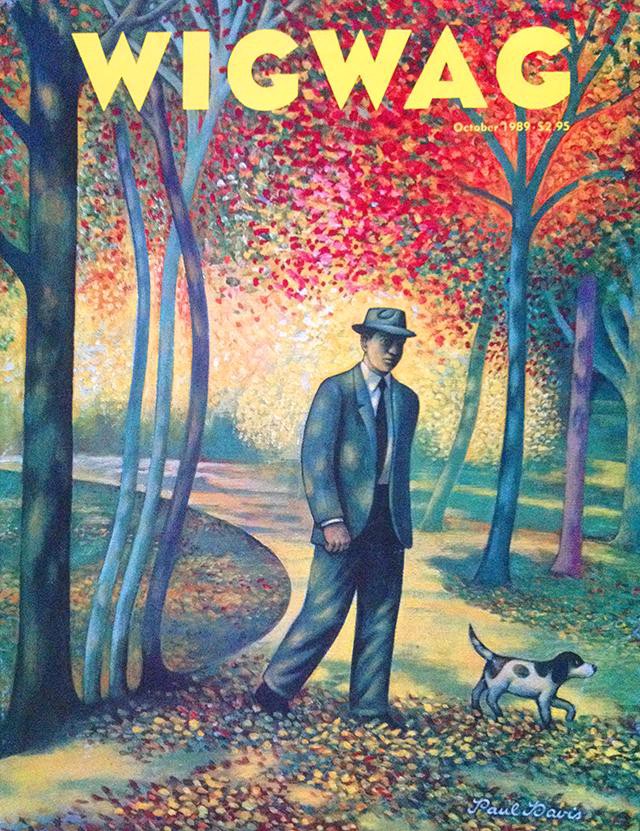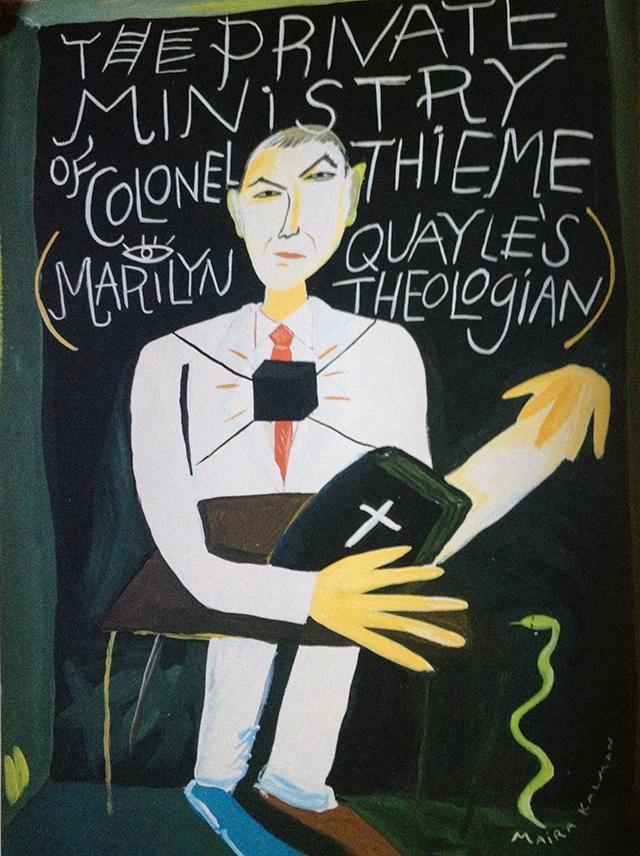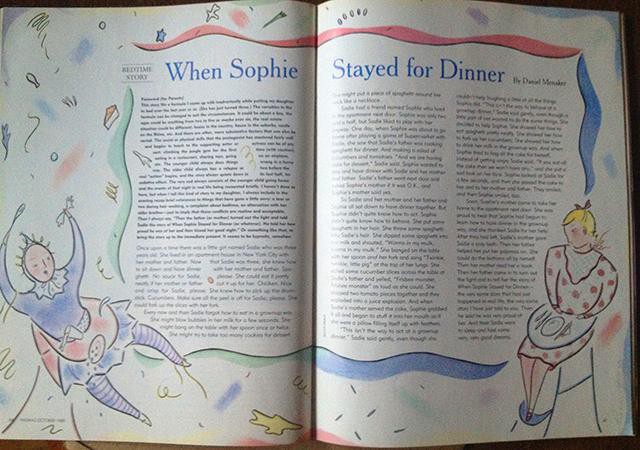'Wigwag' Revisited

It was not a likely name for a magazine. A kid’s magazine, maybe, but a bold attempt to supplant the New Yorker? Eyebrows were raised. And yet Wigwag was launched anyway, in the fall of 1989. Editor Alexander Kaplen wrote in his introductory note: “The word isn’t made up, and the name’s no accident. This magazine has a lot to do with home — who lives where, what they do there, what they do there.” The definition, according to Kaplen, is, “to signal someone home.” Kaplen launched the magazine as a response to the ousting of long-time editor William Shawn in 1987 (detailed extensively by Elon Green last week). If Eustace Tilley was going to be co-opted by some outsider, then Kaplen was going to re-imagine that eminent magazine as one no longer the Talk of the Town (and you know which town), but rather the talk of all the towns, even the one in which you may live, be it Iowa City or Akron or Winnemucca.
Wigwag was apparently quite successful, reaching a circulation of 200,000, and was also well-regarded, at least until it ceased publication two years later.

I snagged a copy of the introductory issue, October 1989, on Ebay. (Not actually the first issue; there was a test issue a year and change earlier.) It’s in beautiful shape, and it’s a beautiful magazine, staple-bound, with thick low-gloss paper that they don’t seem to use anymore. The cover is an assured declaration of intent, no copy other than the title/price/date, a Paul Davis oil of a suited man, a small dog, an autumnal path through the woods. It is confident, a shot across the bow of That Other Magazine.
Inside, it favors artwork (art directed by Davis) over photographs, twining into the mission of homeliness (that of “being home,” not the other kind), with evocative, uniquely American illos by the likes of Maira Kalman, Gary Baseman and Elwood H. Smith. It’s artsy, it’s craftsy. The art is not just used as a splash to kick off a piece. Interior pages are bordered or cornered with these works, sometimes creeping across the gutter, sometimes swirling into a column of copy. It’s like a zine from the old days, but one that your successful, patrician grandparents would have produced.
And oh my God, the ads. Of course it was 1989, when magazines were enormously viable constructs at whom any advertiser would throw gobs of money, but when you flip through the upstart Wigwag, you see no difference between their ad pages and the advertisers you might have seen in Interview or Vanity Fair: Tanqueray? A Keith Haring Absolut ad? Stephen Sondheim for Amex? Two-page spread for the CD of the Month Club? A Smith-Corona, introducing “the world’s first laptop word processor?” All there. If there was anybody at the time concerned about the threat that Wigwag might hold to the New Yorker or anyone else in the high end of the market, the ad spends were no source of solace.

The geography of the interior of the magazine is a bit of an odd duck. According to the Table of Contents, your basic front-of-the-book is called POLITICS, then comes your FEATURE, then a palate-cleansing LETTERS FROM HOME, then of course FICTION, and THE ARTS at the end. Nothing ground-breaking, structurally, nor anything glaring, but there is a feeling that all the pieces at the front, middle and back could just be called SHORT THINGS and everything else IMPORTANT THINGS. This may be more about magazine publishing than it is about Wigwag.
The OED only partially confirms Kaplen’s definition of “wigwag,” agreeing that back and forth motion is involved, but failing to mention anything about home. Nonetheless, in the POLITICS section, there is some furious waving back and forth, thirty pages of ten short non-fiction pieces, none of them about politics.
Kicking things off is Indignities, a curation of obscure current events factoids, the sort of which that were later popularized into obstreperousness by the internet. A plumber in Oregon that wants to mandate AIDS tests! Oh, those plumbers! There is a listicle, or whatever they called listicles back then (the Wigwag Timeline!), a tart little illustration of men’s hat/necktie/show fashion over the history of the U.S. There’s some light comedy (a single shout, a handful of murmurs), there’s a profile of a preparator from the American Museum of Natural History. Where is she now, I wonder? Is her appearance in a twenty-something-year-old magazine worth disturbing her anonymity with a Google search? There is a piece by the first of the bold-faced name contributors, theater critic John Lahr, discussing the then-current embrace by the London establishment of playwright Arthur Miller and his observation of the decline of theater and everything else to a group of British intellectuals that would actually listen to him.
An essay by Suzanne Mata about parenting, about the rebellious teens of the time, is a nifty little snapshot of 1989. Mata’s daughter, roughly twenty years old, was no longer rebelling against the mother, but rather against the state. This particular daughter was active in ACT-UP in New York City. So banners are made (SILENCE EQUALS DEATH), and Mom tags along to a street protest, at which daughter and her compatriots are arrested and strip-searched down at the Tombs. It’s a brave new world, and the next generation is organized and committed to keeping it that way. It’s very Occupy, twenty years before Occupy invented themselves.

Closing out the front is a very fabulous bit of visual representation of data called The Family Tree, intended as a recurring bit. This one is a history of the American sitcom as indicated by the interlocking careers of the writers/producers up to that point. There are over fifty such talents included, and each is tracked via a different line, rendered in what looks to be colored pencil. All of the greats are there, from Mel Brooks and Buck Henry to James L. Brooks (no relation) to “new kid” Linda Bloodworth. I spent a good fifteen minutes digging into it. If you’re any kind of student of the field, it’s invaluable, and noteworthy for one omission (Susan Harris’ “Soap,” although her husband Paul Junger Witt is included), and one inclusion (Samuel Beckett) (!!).


The sole feature story, helpfully labeled THE FEATURE, is by Gary Wills, already a winner of the National Book Award for Nonfiction, later to nab a Pulitzer for Lincoln at Gettysburg. It is titled “The Private Ministry of Colonel Thieme (Marilyn Quayle’s Theologian).” This had some newsworthiness at the time, as Marilyn was the husband of Dan Quayle, the then-vice president, who was a punchline then, and has since risen to the level of time-worn punchline with some progeny who are currently active but not quite elected (son Rep. Ben Quayle lost a redistricting primary in Arizona to David Schweikert last year.) The blurb is more a spoiler than a teaser:
Last fall rumors surfaced (and were quickly squelched) that Marilyn Quayle and her family were under the influence of an evangelical preacher who communicated with them through tapes, that they had listened to him every week, that he was something of a nut. But nobody would talk — not the Quayles, not the minister. GARY WILLS has interviewed him, and reports that the rumors were true.
Well for heaven’s sake why read? Because, getting there is all of the fun. Robert B. Thieme, Jr. was a controversial evangelist of the day, one that insisted that the proper way for his flock to worship was to listen, either in person or via the distribution of tapes, to his preachings. Nothing like your Bakkers or Falwells at all. He was rumored to be a favorite of the Quayles, specifically Marilyn Quayles’ parents.
The story is a bit of a bait and switch. If you’re reading for deep insight into the Quayles, you came to the wrong place. But it is a rigorous examination of the career and teachings of Thieme. Wills had an obvious familiarity with public religious (Christian) figures of the time, and tortures through the writings and speaking of Thieme (“pedantic lectures on dogma”), with whom Wills obtained a rather exclusive interview in the presence of Thieme’s phalanx of sycophants. “But he is an intellectual phony,” Wills writes, and then goes on to prove it. But the ties to the Quayle family, then a comical irrelevance, and now an historical one, were noticed but not mined. I’m sure that at the time the Christian fundamentalists were scandalized by the harsh light shined on Thieme, but the Quayles, with visions of a run after the elder George Bush’s second term, were breathing all sorts of sighs of relief.
Thieme passed away in 2009. Dan Quayle, of course, went on to be what he is to this day: Dan Quayle.

Now we come to a LETTERS FROM HOME, illustrated with rustic pastel cartoons dotting the pages. It’s five dispatches from the correspondents, far-flung across the nation. Most striking is Carmen Delzell from Baltimore, with a sweet tale of a middle-aged landing in Charm City and the handyman who raises her eyebrows, but there’s also a barroom conversation with bank examiners on the road in Lewisburg, WV, and something about the Armenians of Los Angeles. The clear anachronism (looking back) is Mary Norris in Astoria, with a meditation on donut shops and Weight Watchers that would have many firing up the time machine to slap a Trigger Warning on that sucker. But at the same time: it’s 1989. Weight Watchers was a thing then. Also, Cathy was a popular comic strip. Them’s the times that was.
And note that none of the cities chosen are Manhattan. The entire endeavor is deliberately blind to the media capital of the world, an effort not just to take on the New Yorker but also New York in general. Wigwag could as easily be called Flyover.
Now that we’ve confirmed that there is an America outside of Gotham, we arrive at the FICTION section, a must if a magazine wants to make weight to punch with the likes of the New Yorker. The first piece is a sort of a how-to on child-rearing from Daniel Menaker entitled “Bedtime Story.” Menaker was at the time a fiction editor for the New Yorker — intrigue! The piece is entitled “Bedtime Story” and it is just that, a story that one tells one’s child at bed time, incorporating the events of that day, subtly engineering one’s child to be mannerful and obedient. The longer story is from Jacqueline Carey (no, not the historical fantasist, but rather the author of short stories, partner of Ian Frazier). It’s called “Saving Fern,” and it’s a light, stylish tale of two 30ish women from the city traveling to friends’ upstate to rescue/not rescue another friend, a Manic Pixie Dreamgirl prototype. Neither jump out as a William Maxwellian attempt at Quality, but both are quite good.

(There are poems too. I read them. Even a Robert Pinsky!)
Finally we arrive at THE ARTS, filling out the end pages of the magazine, though not all of the subjects are technically the Humanities. Edward Hoagland introduces himself as the book reviewer with a nice piece on a sixteenth-century chronicler of Cortez’s conquest of the Aztecs, Bernal Diaz. But then there is a rambling effort under the heading Great Outdoors about a park in Westchester, and another rambling sports piece, redolent of Roger Angell, which purports to introduce the quirky new game called “baseball” to an unaware public. The food column nicely anticipates the hipstervore ragnarok that would come to pass by singling out American artisanal cheese as nowhere near stinky enough, thanks to a national culinary prudishness. The Architecture column is a winner, as Witold Rybczynski reconsiders the design of the suburban home and the picture window, with a special guest appearance by Frank Lloyd Wright. And for music, an appreciation of the resurgence of then-62 year old Tony Bennett stands out mostly for the curious typo of the incongruous former labelmate of Bennett, the band “Arrowsmith.”

Wigwag is an artifact of a past era. (It is impossible, now, not to think WigWag as the actual name.) It’s dog-eared in places, but it was ambitious and distinctive, and it was assertive of its purpose. It was like the New Yorker (and how could it not be, with a masthead and contributors full of then-present and future New Yorker staff), but it was trying to devise an aesthetic that was inclusive instead of exclusive, that was purposefully national in its breadth.
Of course, when reconsidering Wigwag, the invisible elephant in the room is not so much the New Yorker as it is one other magazine launched in the late 80s, and one that you’ve definitely heard of: Spy. Spy began a few years earlier, in 1986, but they both met unfortunate, early demises. (Wigwag at least went out with a crowd, in 1991: 7 Days had just been shuttered after only two years, and Forbes closed Egg in 1991 as well.) The influence of Spy as the birthplace of snark is undeniable, but Wigwag had its echoes too, mostly in design. (Back in 2008, Designing Magazines made the case that the “specific visual language” of Spy influenced New York, Vanity Fair and Radar, but from here in 2013, that may be look like something of an evolutionary dead end as well.) But where Wigwag was soft and rounded, Spy was angular and rakish, and it was that nattiness that survived the first Iraq War and the bad economy that followed it, until at last in 1998 it expired for good as well — the same year that Omni was finally done.
The backpage feature of Wigwag is called MAP, and its intention was to have readers submit a little map of their life’s journey, in this case, for a woman named Linda Warner, from Seattle to Maplewood, NJ. Wigwag may be largely forgotten, but magazine publishing did definitely pause there for a brief time as the 80s bled into the 90s.
